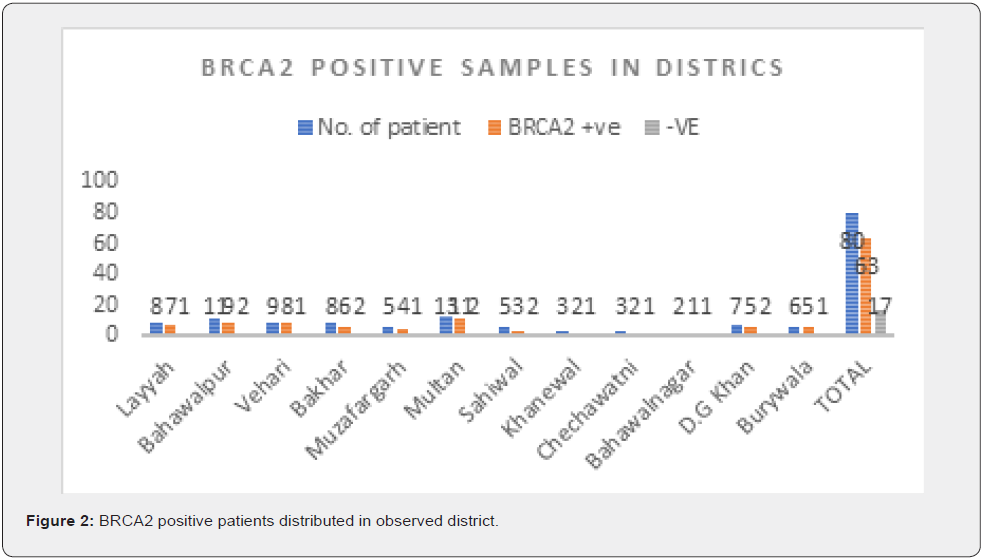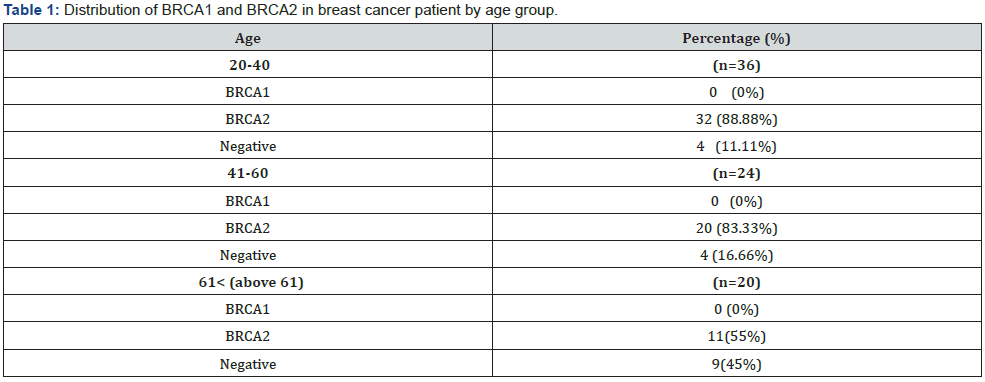Molecular Analysis of Breast Cancer BRCA1 and BRCA2 in Southern Punjab
Hira Ahsan1, Maryam1, Muhammad Zeeshan Ahmad1, Atta ul Mustafa1, Muhammad Waqar Mazhar2*and Hira Tahir3
1Department of microbiology, Government College University, Faisalabad, Pakistan
2Department of Bioinformatics and Biotechnology, Government College University, Faisalabad, Pakistan
3University of Health Sciences, Lahore, Pakistan
Submission: September 20, 2022; Published: September 29, 2022
*Corresponding Address: Muhammad Waqar Mazhar, Department of Bioinformatics and Biotechnology, Government College University, Faisalabad, Pakistan
How to cite this article: Muhammad W M. Molecular Analysis of Breast Cancer BRCA1 and BRCA2 in Southern Punjab. Canc Therapy & Oncol Int J. 2022; 22(3): 556088. DOI:10.19080/CTOIJ.2022.22.556088
Abstract
Background: Carcinoma of the breast cancer is the most common malignancy in females. Approximately one in every nine Pakistani women is likely to suffer from breast cancer showing an incidence rate of 50/100,000 and breast cancer is growing at an alarming rate in Pakistan. The main causative element remains unknown, yet primary risk factors identified are sex, age, parity, genetics, lack of child bearing, breast feeding, higher hormonal levels and individual lifestyle etc in Indian and Asian women as compared with western women.
Methods: 80 samples were collected from MINAR. DNA isolation from blood samples then amplify BRCA1 and BRCA2 gene and then run-on gel electrophoresis.
Results: The 63 (78.75%) out of 80 patients were BRCA2 positive and showed the amplification BRCA2 gene while 17 individuals were negative and not showed the amplification of both BRCA1 and BRCA2 genes, and no BRCA1 amplification (0%) was observed. The most affected female age groups were 31–40 and 41–50 had the highest risk. In this study the average mean of age 50.0 ± 8.1, BRCA2 9.0±2.4 and negative 1.99±0.75 was observed in 80 patients of breast cancer. The maximum patients of BRCA2 were present in 40 ages while minimum was observed in 20 and above 60 age. The paired t test was applied to check the correlation between age and BRCA 1and BRCA2 patients. The results indicated that significant (<0.05) correlation was found between age group and appearance of BRCA2 in 80 breast cancer patients. The highest BRCA2 positive patients were observed in Multan (11) district and lowest were found in district Khanewal and Chechawatni (2). The present study concluded that the age is the main factor that cause the mutation in BRCA2 that leads to breast cancer in female belong to southern Punjab.
Introduction
Breast cancer mostly occurred in female due to unlimited growth of breast tissue. Hormonal imbalance, genetic mutation and environmental factor are the major source of breast cancer. Previous studies reported that 23% of all cancer types diagnosed in females [1] While until 2012 globally 1.4 million breast cancer cases are diagnosed every year [2]. Breast cancer was the most common malignancy with 6.6% are diagnosed in young women below 40 years [3].
The ratio of breast cancer was high in developing countries (71.7/100,000) as compared to under developing countries (29.3/100,000) [4]. Its incidence in Pakistan is 2.5 times higher than that of neighboring countries like Iran and India. According to the research conducted by Indian Medical council predicts that the cases of breast cancer patients were 106,124 in 2015 and it is estimated that the cases will rise up to 123,634 in 2020 [5]. One of nine women suffers from breast cancer [1]. In a study from Shaukat Khanum Memorial Cancer Hospital, Pakistan, breast cancer accounted for 21.5% out of all cancers in general population and for 45.9% of all the cancers in females.
The reason for the relatively high rates of cancers of the breast is not known. Lifestyle and reproductive factors may influence the incidence of breast cancer. The risk factors associated with breast cancer are age, family history, early menarche, intake of combined estrogen and progesterone (menopausal hormones), alcohol consumption, physical inactivity and lack of awareness regarding this disease. BC also possible that genetic factors such as BRCA1 (MIM 113705) and BRCA2 ( MIM 600185) gene {MAZHAR, 2021 #491}.
BRCA1 and BRCA2 are called high penetrance genes {MAZHAR, 2021 #491}. The proteins encoded by these genes are suggested to act as tumor suppressors and involved in the maintenance of genomic reliability [6]. The disease was linked to BRCA1 in an estimated 52% of families, to BRCA2 in 32% of families, and to neither of them in 16%. The majority of families with male and female breast cancer were due to BRCA2 (76%) [7].
Material and Methods
Families
Breast cancer families were ascertained at MINAR in Multan, Pakistan from June 2018 to December 2018. 80 Breast cancer samples were collected. They were classified into 7 categories based on family history:
Group A1: Families with female breast cancer diagnosed under 40 years of age.
Group A2: Families with female breast cancer diagnosed 41 - 60 year of age.
Group A3: Families with female breast cancer diagnosed above 61 years of age.
This study was carried out on breast cancer in female belong to the southern Punjab (from district Burrywala, Layyah, Khanewal, chichawatni, D.G Khan, Bahawalpur, Multan, Vehari, Muzaffargarh, Bakkhar and Sahiwal) Pakistan.
DNA Isolation
Genomic DNA was extracted from 20 ml heparin blood samples using the Favorgen PrepTM DNA Extraction Kit, according to manufacturer’s instruction. The PCR reaction was as follows: 95 oC for 4 min, 95oC for 1mint, 49oC for 30 sec, 72oC for 1min, 35 cycles, followed by a 5 min final extension at the 72 oC. Amplified BRCA1 and BRCA2 DNA was further checked on 1.5 % agarose gel for the resolution of different band patterns.
Statistical Analysis
The statistical analysis was done by t-test and significant measure (p<0.05) (0.2).
Results
The age was categorized into 3 groups, 20-40, and 41-60 and above 61 age formed 1st, 2nd and 3rd group. Number of patients in age groups 20-40, 41-60 and above 61 were, 36, 24 and 20, respectively. The no of patient was found in order of 36 >24 > 20 in 1st, 2nd and 3rd age groups, respectively see in Table 1. The 63 (78.75%) out of 80 patients were BRCA2 positive and showed the amplification BRCA2 gene while 17 individuals were negative and not showed the amplification of both BRCA1 and BRCA2 genes, and no BRCA1 amplification (0%) was observed in blood samples of 80 breast cancer patients in different region of southern Punjab see in figure 1. The highest BRCA2 positive patients were observed in Multan (11) district and lowest were found in district Khanewal and Chechawatni (2). The BRCA2 positive patients were found in order of Multan> Bahawalpur> Vehari> Bakhar> D.G.Khan =Burywala> Muzaferghar > Sahiwal > Khanewal=Chechawatni > Bahawalnager see in figure 2.


Discussion
In Pakistan, the most diagnosed cancer among females is breast cancer, accounting for nearly one in nine female patients. Its incidence in Pakistan is 2.5 times higher than that in neighboring countries like Iran and India [1]. The risk factors associated with breast cancer are age, family history, early menarche, nicotine consumption, 1st child birth, physical inactivity and lack of awareness regarding the disease [8].
Age is one of the most important risk factors for breast cancer. It is a common observation that risk of breast cancer increases with age. Median age of 49 in the patients with breast cancer is much lower than median age seen in American population at 62 years [9]. The results of previous studies were correlated with the present studies i-e which showed the lower mean age that is closer to that in this study. A cross-sectional study involving 250 patients in NICRH, found the mean age of the study group was 44.7 years, standard deviation (SD) was 9.82 (range: 21-67) [10]. In this study, we analyzed that in the patients of below 50 age, there is 63.75% association with the disease. This population displays a peak in breast cancer incidence between 30 and 50 years of age. The lowest age was 20 highest age was 78 and the mean age was50.0 ± 8.1.

The incidence of breast cancer is increases in southern Punjab. We found that BRCA2 incidences more in Vehari (88.88%), Layyah (87.5%), Multan (84.61%), Bahawalpur (81.81%), Burywala (83.33%), Muzaffargarh (80%), Bakhar (75%), Khanewal (66.66%), Chechawatni (66.66%), D.G khan (71.42%), Sahiwal (60%), Bahawalnagar (50%). The main cause of this disease is lack of awareness and industrial effluent direct exposure to environment. The incidence of breast cancer increases alarmingly especially among the urban women in southern Punjab because one of the reasons causing cancer was the changing diet habits especially since the advent of fast foods, smoking and liquor under the influence of the western world. Increased awareness by education is very important and may play a preventive role [11].
Conclusion
Occurrence of breast cancer has undergone an age shift. This important issue will influence screening programs for breast cancer detection at early stage and alert women regarding various risk factors thereby Preventing compromise of the outcome of this disease.
Acknowledgement
Authors would like to thank Department of Biotechnology, Faisalabad Institute of Research Science and Technology and Al- Azhar Hospital for overall support specially Dr. Ahsan Azhar.
References
- Asif HM, Sultana S, Akhtar N, Rehman JU, Rehman RU (2014) Prevalence, risk factors and disease knowledge of breast cancer in Pakistan. Asian Pac J Cancer Prev 15(11): 4411-4416.
- Formenti SC, Arslan A A, Love S M (2012) Global breast cancer: the lessons to bring home. Int J Breast Cancer 2012:
- Adams C (2011) Molecular mechanisms of drug resistance in a triple negative breast cancer cell model.
- Youlden DR, Cramb SM, Dunn NA, Muller JM, Pyke CM, (2012) The descriptive epidemiology of female breast cancer: an international comparison of screening, incidence, survival and mortality. Cancer epidemiology 36(3): 237-248.
- Sarawgi M, Singh S, Kumar A, Ekka S, Kumar S (2017) Evaluation of Breast Cancer in Reference to Skin Changes. Journal of Medical and Dental Science Research 4(5): 21-30.
- Paul A, Paul S (2014) The breast cancer susceptibility genes (BRCA) in breast and ovarian cancers. Frontiers in bioscience (Landmark edition) 19(4): 605-618.
- Ford D, Easton D, Stratton M, Narod S, Goldgar D, et al. (1998) Genetic heterogeneity and penetrance analysis of the BRCA1 and BRCA2 genes in breast cancer families. Am J Hum Genet 62(3): 676-689.
- Nessa A, Hussain T, Alam SM, Faruk I, Jahan I (2018) Age distribution pattern of female breast cancer patients in Bangladesh-developing early and presenting late. International Surgery Journal 5(2): 379-382.
- Anderson WF, Pfeiffer RM, Dores GM, Sherman ME (2006) Comparison of age distribution patterns for different histopathologic types of breast carcinoma. Cancer Epidemiology and Prevention Biomarkers 15(10): 1899-1905.
- Rahman M, Ahsan A, Begum F, Rahman K (2015) Epidemiology, Risk Factors and Tumor Profiles of Breast Cancer in Bangladeshi underprivileged women. Gulf J Oncolog 1(17): 34-42.
- Mitra A, Pradhan R, Mukherjee S (2009) Importance of heart-healthy diet. Journal of Human Ecology 27(1): 53-61.






























